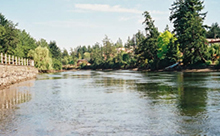 The body of water known simply as “The Gorge” to Victoria locals is a narrow tidal inlet that connects Victoria Harbour to Portage Inlet. The Gorge Waterway is defined as the inlet between Craigflower Bridge and the Selkirk trestle. The Gorge has a rich history as an important spiritual place and food-gathering area for First Nations, and as a recreation area for Victoria residents. Many decades of pollution entering the Gorge from sewage and industrial wastes seriously degraded the water quality by the 1940s. Clean-up efforts beginning in the early 1990s have reversed this trend, and water quality has improved significantly. This is important for the health of valuable fish and wildlife habitat in the Gorge, as well as for aesthetic and recreational values.
The body of water known simply as “The Gorge” to Victoria locals is a narrow tidal inlet that connects Victoria Harbour to Portage Inlet. The Gorge Waterway is defined as the inlet between Craigflower Bridge and the Selkirk trestle. The Gorge has a rich history as an important spiritual place and food-gathering area for First Nations, and as a recreation area for Victoria residents. Many decades of pollution entering the Gorge from sewage and industrial wastes seriously degraded the water quality by the 1940s. Clean-up efforts beginning in the early 1990s have reversed this trend, and water quality has improved significantly. This is important for the health of valuable fish and wildlife habitat in the Gorge, as well as for aesthetic and recreational values.
The Gorge Waterway Initiative (GWI), formed in 2005, is a collaborative group of community organizations concerned with protecting and enhancing the natural and cultural features of the Gorge Waterway and Portage Inlet. The GWI coordinates information exchange, initiates restoration projects and provides education and outreach in the community.
About the Gorge Waterway
- Size (total area): 54.5 ha
- Total length of shoreline: 17,494m (including Portage Inlet)
- Depth of harbor (average): <5m
- Creek that flows into the harbour: Gorge Creek
- Number of stormwater discharges: 84
- Protected areas: Victoria Migratory Bird Sanctuary
- Species at risk: Olympia oysters, great blue heron
- History
Valued Habitat
Eelgrass
Extensive eelgrass meadows are one of the most important biological features of the Gorge. These plants grow in soft sediment, and provide sheltered habitat for fish such as juvenile Pacific salmon and cutthroat trout. Decaying eelgrass leaves and other plant matter, called detritus, nourishes a complex food web of other animals, mostly invertebrates. The rhizomes (branching roots) of eelgrass are important for trapping sediments and reducing shoreline erosion.
Kelp Beds
Kelp includes several species of large brown algae that anchor to rocky substrates with a holdfast, and have large leaf-like blades for capturing sunlight. In the lower Gorge (below the narrows) kelp beds cover about 60% of the subtidal surface. Kelp provides important habitat and/or a food source for fish and marine invertebrates. In many areas, kelp beds help attenuate the effects of wave action on the shoreline.
Oyster Beds
The native Olympia oyster (Ostrea lurida) is another significant species found in the Gorge Waterway. Historically, this oyster was an important food source for First Nations and non-aboriginal residents. Due to over-harvesting, pollution and predation from invasive species, large Olympia oyster beds are now rare on the west coast of North America. Olympia oysters are food for animals such as snails, limpets, sea stars and birds. Since oysters are filter feeders, they help to clear the water of sediment and organic matter.